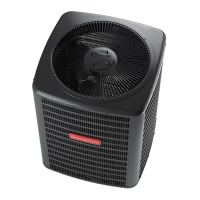How to check faulty transformer in Goodman GSC13036?
- BBreanna ParkSep 1, 2025
If your Goodman Air Conditioner has a faulty transformer, check the control circuit with a voltmeter.

How to check faulty transformer in Goodman GSC13036?
If your Goodman Air Conditioner has a faulty transformer, check the control circuit with a voltmeter.
How to test faulty thermostat in Goodman GSC13036?
If the thermostat is faulty in your Goodman Air Conditioner, test the continuity of the thermostat and wiring.
How to test open overload in Goodman GSC13036?
If your Goodman Air Conditioner has an open overload, test the continuity of overloads.
What to do if Goodman GSC13036 Air Conditioner has noncondensibles?
If your Goodman Air Conditioner has noncondensibles, recover the charge, evacuate, and recharge.
How to test shorted or broken wires in Goodman GSC13036 Air Conditioner?
If your Goodman Air Conditioner has shorted or broken wires, test the circuits with an ohmmeter.
How to fix loose connection in Goodman GSC13036 Air Conditioner?
If your Goodman Air Conditioner has a loose connection, inspect the connection and tighten it.
What to do if Goodman Air Conditioner has overcharge of refrigerant?
If you have an overcharge of refrigerant in your Goodman Air Conditioner, recover part of the charge.
| Brand | Goodman |
|---|---|
| Model | GSC13036 |
| Category | Air Conditioner |
| Language | English |
Units shipped with holding charge are for component replacement only on existing systems.
Table for determining system superheat based on outdoor dry bulb and indoor wet bulb temperatures.
Safety precautions and steps for adjusting superheat on fixed orifice systems.
General safety guidelines and specific warnings about high voltage hazards.
Specifies technician qualifications required to use this manual.
Guidance on warranty, inspection, and adherence to regulations.
Requirements for unit placement and airflow, including rooftop considerations.
Warning regarding potential hazards during refrigerant handling.
Detailed warnings about refrigerant properties and safe handling procedures.
Precautions for handling refrigerant cylinders to prevent explosion.
Guidelines for installing refrigerant lines, including insulation and avoiding contact.
Table specifying recommended refrigerant line diameters based on unit tonnage and length.
Requirements for insulating refrigerant lines to prevent condensation and damage.
Checklist for safely burying refrigerant lines underground.
Procedures and precautions for connecting refrigerant lines, including brazing.
Methods for leak testing refrigerant systems and associated warnings.
Methods for pressure testing and locating leaks in the system.
Steps for evacuating the system to the required vacuum level.
Critical warnings and cautions related to refrigerant pressure and compressor operation during evacuation.
Safety warnings and requirements for electrical connections and wiring.
Precautions for starting up, opening valves, and tightening caps.
Information on overcurrent protection devices and three-phase compressor rotation.
Guidance on routing and terminating high and low voltage control wiring.
Warning against overcharging and operating in a vacuum.
Warnings regarding refrigerant overcharging and compressor damage.
Steps for checking and adjusting superheat on fixed orifice systems.
Procedures for adjusting subcooling and superheat on TXV systems.
Formula for calculating subcooling in expansion valve systems.
Table providing target superheat values for various operating conditions.
Chart relating suction pressure to saturated suction temperature for R-22.
Chart relating liquid pressure to saturated liquid temperature for R-22.
A guide correlating symptoms with possible causes of system malfunctions.
Recommended test methods and remedies for identified troubleshooting issues.
Notice regarding the requirement of a Hard Start Kit for specific compressor types.
Manufacturer's statement on product quality and design principles.
Information on where to find additional product and service details online.












